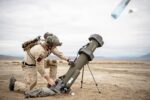Lockheed Martin has secured a $233 million contract to advance the Infrared Search and Track (IRST) Block II system for U.S. fighter aircraft. This next-generation passive sensor enhances long-range detection and tracking of airborne threats without relying on radar emissions—critical in modern contested airspaces dominated by stealth platforms and electronic warfare.
Contract Details and Program Scope
The U.S. Department of Defense awarded Lockheed Martin a $232.8 million firm-fixed-price modification to an existing contract (N0001921C0011) for continued development and production of the IRST21 Block II system. The award covers engineering development, hardware procurement, integration support, testing, and initial production units. Work is expected to be completed by October 2029.
The funding supports both the U.S. Navy’s F/A-18E/F Super Hornet fleet and the U.S. Air Force’s F-15EX Eagle II platform—two fourth-generation fighters that rely increasingly on sensor upgrades to remain competitive against fifth-generation threats such as China’s J-20 or Russia’s Su-57.
What Is IRST21? Passive Targeting Without Radar
IRST (Infrared Search and Track) systems offer a crucial capability in modern air combat by enabling aircraft to detect and track targets via their infrared signatures without emitting detectable radar signals. This passive approach is especially valuable against stealth aircraft designed to evade radar or in electromagnetic spectrum-contested environments where radar use may be degraded or compromised.
Lockheed Martin’s IRST21 is derived from the legacy AN/AAS-42 system used on earlier platforms like the F-14D Tomcat but has undergone significant modernization in optics, processing power, cooling systems, and integration flexibility.
The current IRST21 Block I is already deployed on some U.S. Navy Super Hornets via the Sensor System Supplier (S3) pod mounted in the centerline fuel tank station. The new Block II variant introduces enhanced resolution sensors with improved range performance, better clutter rejection algorithms for complex backgrounds (e.g., overland), upgraded processors using open mission systems architecture (OMS), and more robust target discrimination capabilities under high-G maneuvering conditions.
Platform Integration: Super Hornet & Eagle II
The two primary platforms benefiting from this upgrade are:
- F/A-18E/F Super Hornet: The Navy’s frontline carrier-based multirole fighter uses IRST21 as part of its S3 pod configuration. The integration allows pilots to passively detect airborne threats at extended ranges while maintaining radar silence during maritime strike missions or air superiority operations.
- F-15EX Eagle II: Boeing’s latest iteration of the venerable F-15 incorporates open mission systems that facilitate rapid integration of advanced sensors like IRST21 into conformal fuel tanks or external pods without major structural modifications.
This dual-service adoption underscores DoD’s push toward sensor fusion across legacy fleets as a cost-effective way to maintain overmatch while fifth-gen aircraft like the F-35 focus on penetrating missions.
Tactical Advantages in Contested Environments
The value proposition of IRST lies in its ability to operate passively—making it ideal for operations where emissions control (EMCON) is critical or where adversaries deploy advanced electronic warfare systems capable of jamming or geolocating active radars.
Key tactical advantages include:
- Stealth Detection: Stealth aircraft are optimized against radar; however, they still emit heat signatures detectable by high-resolution infrared sensors at long ranges under favorable conditions.
- BVR Engagement Support: When fused with other onboard data sources (e.g., radar tracks shared via Link 16), IRST can help cue long-range missiles like AIM-120 AMRAAM without giving away position via active emissions.
- Spectrum Resilience: In GPS-denied or EW-heavy environments such as those anticipated in Indo-Pacific conflict scenarios, reliance on passive sensors becomes a strategic necessity rather than an option.
A Modular Path Toward Future Sensor Fusion
The IRST21 Block II upgrade aligns with broader Pentagon goals around modularity and open-systems architecture under initiatives like MOSA (Modular Open Systems Approach). By decoupling software from hardware dependencies through OMS compliance, Lockheed enables easier future upgrades—whether adding AI-powered target recognition algorithms or integrating with unmanned wingmen under programs like NGAD or Collaborative Combat Aircraft (CCA).
This modularity also opens potential export opportunities among allied air forces operating compatible fourth-gen fighters seeking low-risk enhancements amid tightening budgets—a factor likely considered given Lockheed’s global customer base across NATO nations and Pacific allies like Japan or Australia.
Industrial Base Implications & Supply Chain Considerations
The contract supports continued employment across several key Lockheed facilities including Orlando (sensor development), Owego NY (systems integration), and St. Louis MO (pod assembly). Subcontractors such as Collins Aerospace are also involved in cooling subsystems and optics packaging.
Sustained investment into electro-optical/infrared sensing technologies helps preserve critical industrial base competencies that would otherwise erode between major platform procurements—a concern raised repeatedly by GAO reports regarding EO/IR supply chain fragility within DoD acquisitions.
Conclusion: Passive Sensing Meets Modern Threats
The $233 million investment into Lockheed Martin’s IRST21 Block II program reflects growing recognition within DoD that survivability no longer hinges solely on stealth shaping or kinetic range—but increasingly on who sees first without being seen. As near-peer rivals field stealthier assets backed by capable IADS networks and EW suites, passive long-range detection becomes indispensable for both offensive counter-air missions and homeland defense roles alike.










